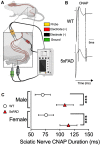Neuromuscular Dysfunction Precedes Cognitive Impairment in a Mouse Model of Alzheimer's Disease
- PMID: 38111538
- PMCID: PMC10727840
- DOI: 10.1093/function/zqad066
Neuromuscular Dysfunction Precedes Cognitive Impairment in a Mouse Model of Alzheimer's Disease
Abstract
Alzheimer's disease (AD) develops along a continuum that spans years prior to diagnosis. Decreased muscle function and mitochondrial respiration occur years earlier in those that develop AD; however, it is unknown what causes these peripheral phenotypes in a disease of the brain. Exercise promotes muscle, mitochondria, and cognitive health and is proposed to be a potential therapeutic for AD, but no study has investigated how skeletal muscle adapts to exercise training in an AD-like context. Utilizing 5xFAD mice, an AD model that develops ad-like pathology and cognitive impairments around 6 mo of age, we examined in vivo neuromuscular function and exercise adapations (mitochondrial respiration and RNA sequencing) before the manifestation of overt cognitive impairment. We found 5xFAD mice develop neuromuscular dysfunction beginning as early as 4 mo of age, characterized by impaired nerve-stimulated muscle torque production and compound nerve action potential of the sciatic nerve. Furthermore, skeletal muscle in 5xFAD mice had altered, sex-dependent, adaptive responses (mitochondrial respiration and gene expression) to exercise training in the absence of overt cognitive impairment. Changes in peripheral systems, specifically neural communication to skeletal muscle, may be harbingers for AD and have implications for lifestyle interventions, like exercise, in AD.
Keywords: 5xFAD; alzheimer’s disease; exercise; mitochondria; neuromuscular; sciatic nerve.
© The Author(s) 2023. Published by Oxford University Press on behalf of American Physiological Society.
Conflict of interest statement
The authors have no conflicts to disclose.
Figures






References
-
- Linn RT, Wolf PA, Bachman DL et al. The “preclinical phase” of probable Alzheimer’s Disease: a 13-year prospective study of the Framingham cohort. Arch Neurol. 1995;52(5):485–490. - PubMed
-
- Norton S, Matthews FE, Barnes DE, Yaffe K, Brayne C. Potential for primary prevention of Alzheimer’s disease: an analysis of population-based data. Lancet Neurol. 2014;13(8):788–794. - PubMed
Publication types
MeSH terms
Grants and funding
LinkOut - more resources
Full Text Sources
Medical
